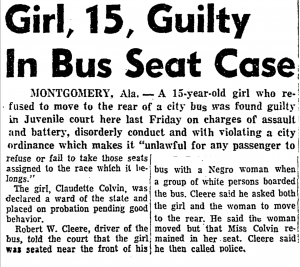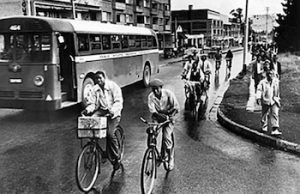“Girl, 15, Guilty In Bus Seat Case”, Chicago Defender, (1955)

The 1955 Chicago Defender article presents the ruling of a case about a 15-year-old African American girl refusing to move from her seat. The girl, Claudette Colvin, was riding a Montgomery, Alabama bus when she refused to move to the back of the bus. During the early-1900s, African Americans were forced to sit in the back of public buses, if white people entered the bus. Colvin was found guilty, but her message and action would be heard nationally. Colvin would inspire Rosa Parks several months later to refuse to move from her seat, which would draw national attention, unlike Colvin’s story. Colvin’s refusal would also help lead to the Montgomery Bus Boycott, which would have African Americans refusing the use of Montgomery, Alabama’s public transportation. Colvin’s stand against the unjust bus segregation would help influence the end of bus segregation with the ruling in 1956.
“United We Stood” photo, (1955)
 This 1955 displays African Americans walking and riding bikes instead of using the public bus that is adjacent to them. The large crowd of African Americans seems to be going to work, but the significance of the photo is the lack of use of public transportation. Most middle and lower class people during the mid-1900s took public transportation to work. The Montgomery Bus Boycott is being depicted here, which took place from 1955-1956. Although African Americans were discriminated by public transportations, they were still a huge part of the public transportation’s revenue. The Montgomery Bus Boycott would force the Supreme Court to rule for integration in Montgomery’s bus system, which was a monumental step for African Americans in achieving equality. The successful boycott would also create a substantial following behind the leader of the boycott, Martin Luther King Jr, who would help African Americans obtain civil rights in the years following.
This 1955 displays African Americans walking and riding bikes instead of using the public bus that is adjacent to them. The large crowd of African Americans seems to be going to work, but the significance of the photo is the lack of use of public transportation. Most middle and lower class people during the mid-1900s took public transportation to work. The Montgomery Bus Boycott is being depicted here, which took place from 1955-1956. Although African Americans were discriminated by public transportations, they were still a huge part of the public transportation’s revenue. The Montgomery Bus Boycott would force the Supreme Court to rule for integration in Montgomery’s bus system, which was a monumental step for African Americans in achieving equality. The successful boycott would also create a substantial following behind the leader of the boycott, Martin Luther King Jr, who would help African Americans obtain civil rights in the years following.
